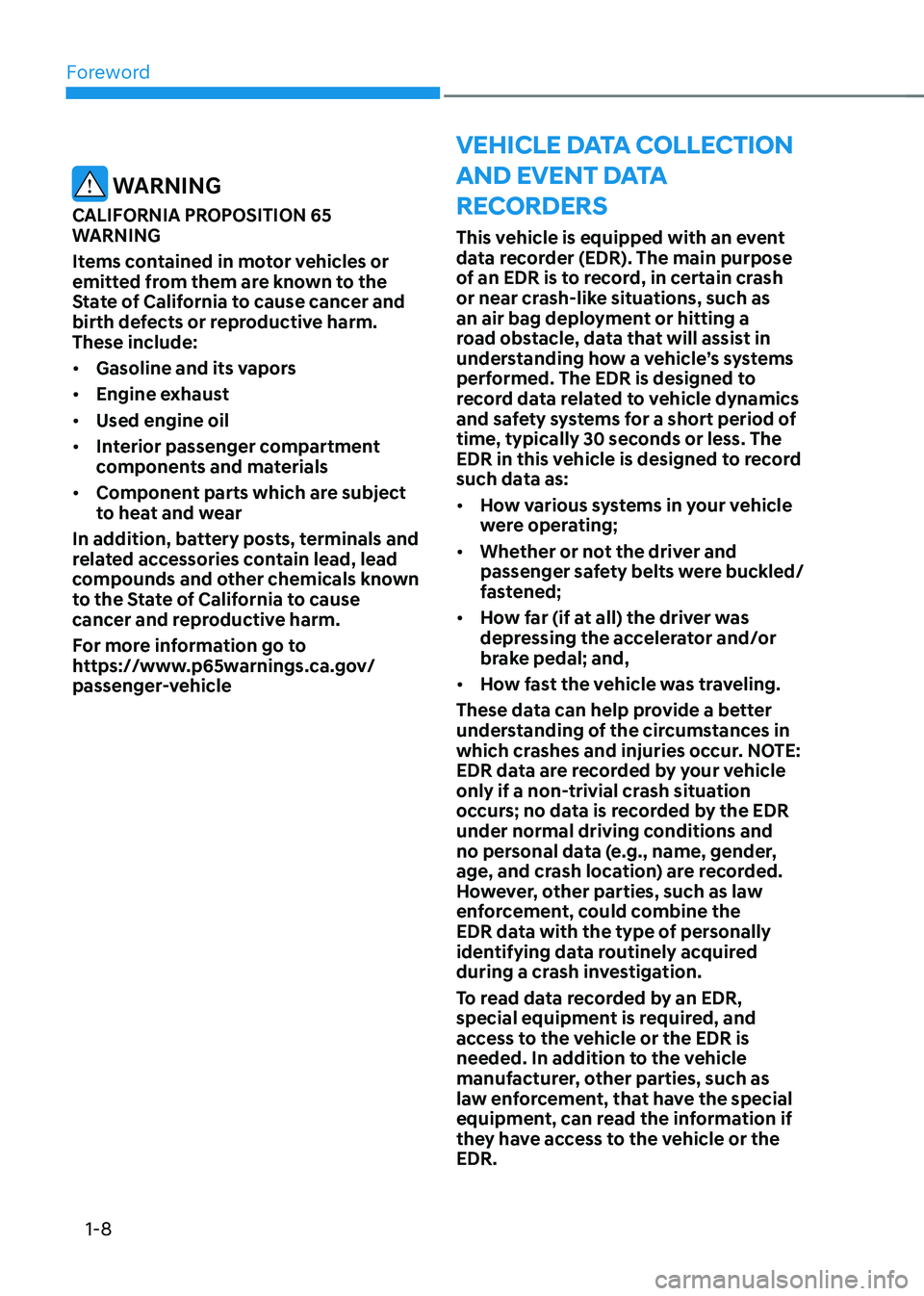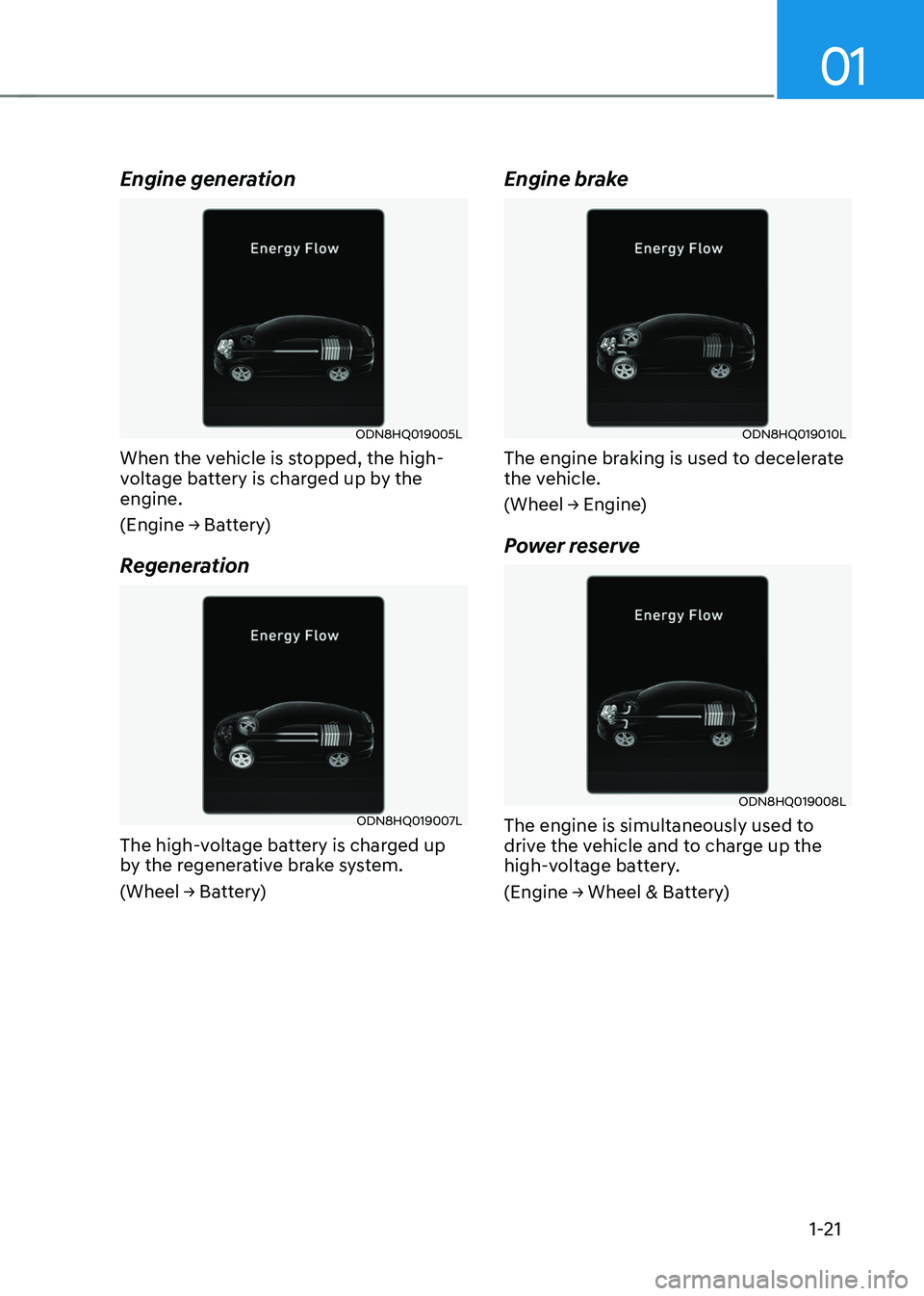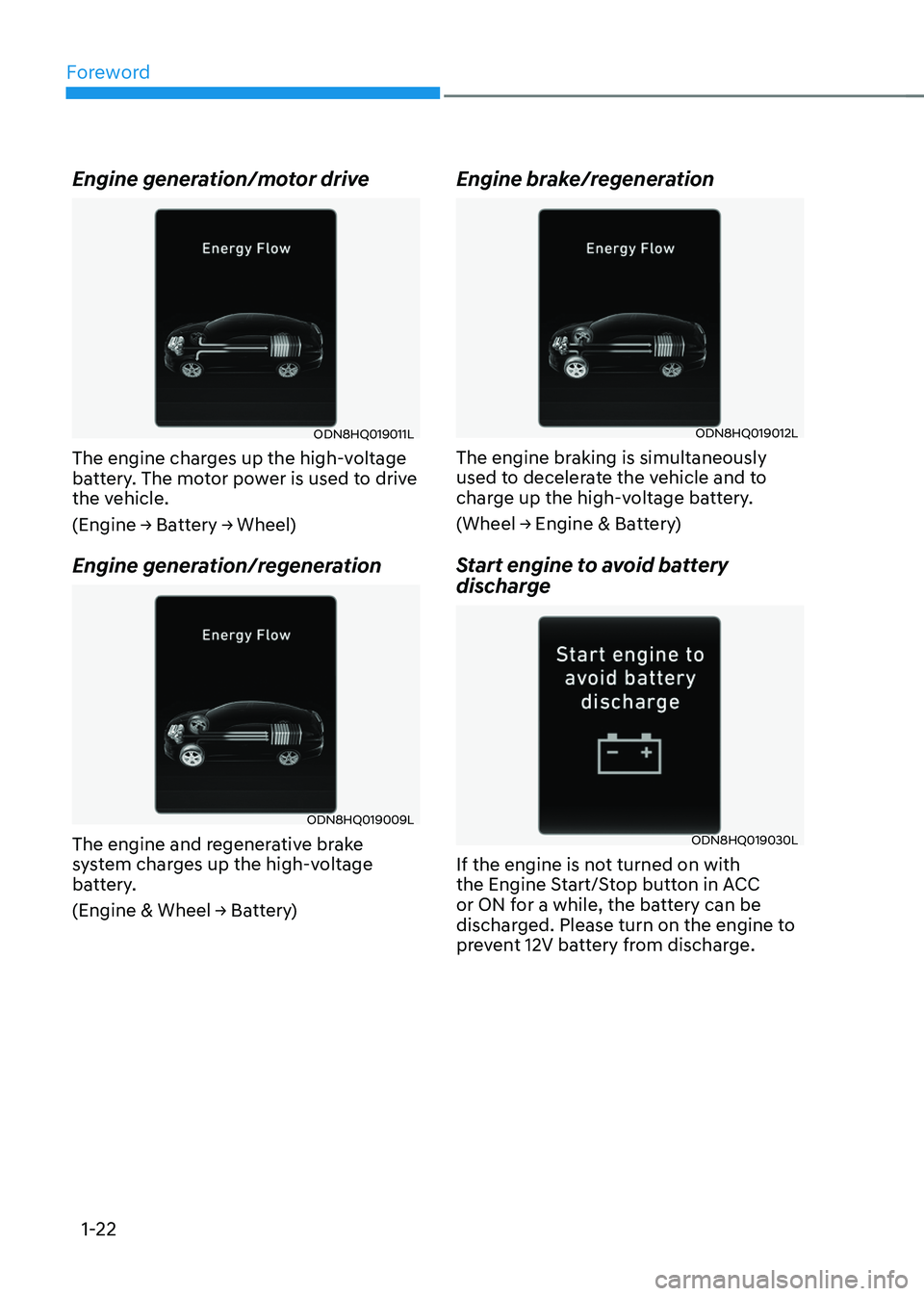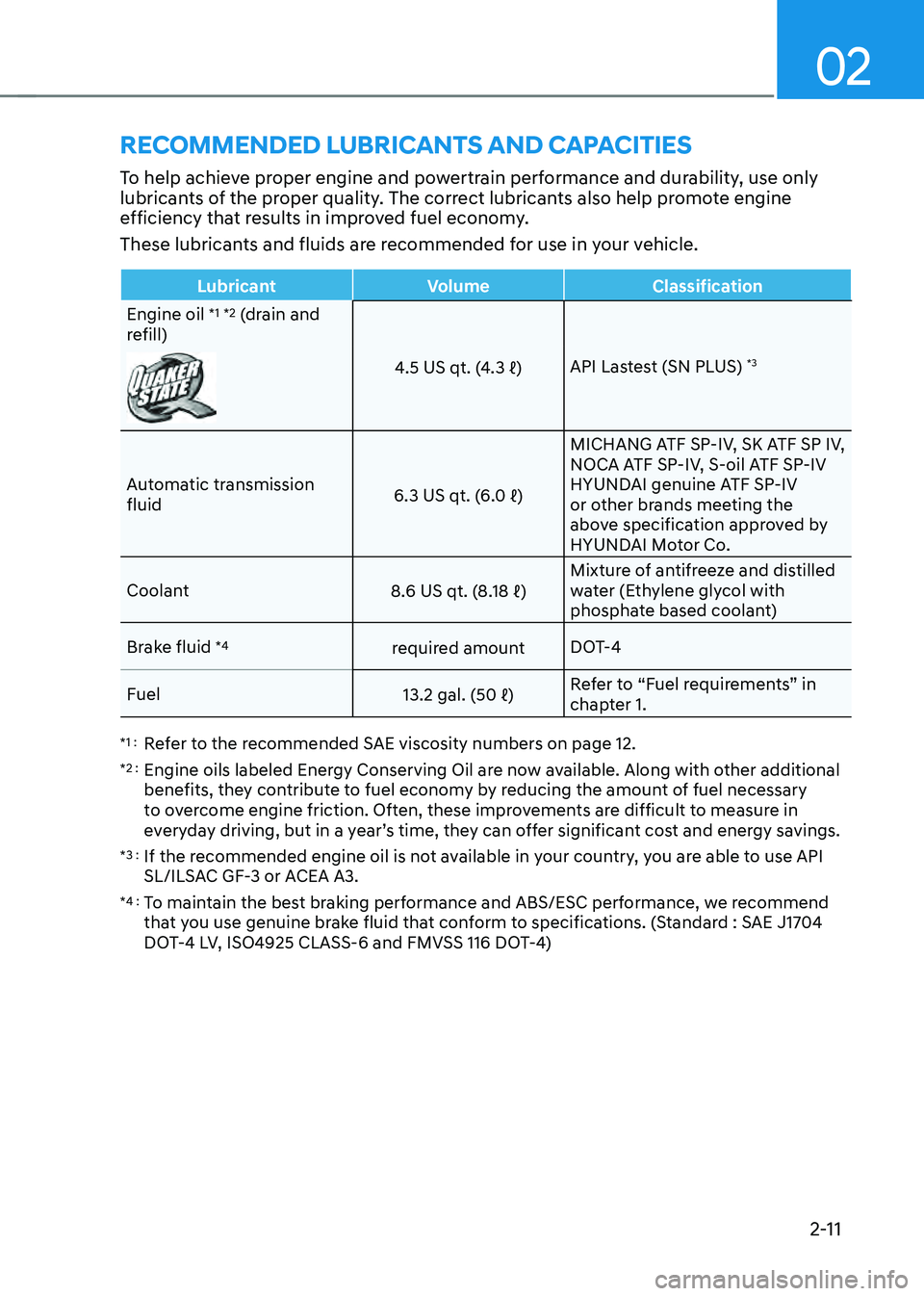2022 HYUNDAI SONATA HYBRID Engine brake
[x] Cancel search: Engine brakePage 12 of 527

01
1 -7
Detergent Fuel Additives
HYUNDAI recommends that you use
good quality gasolines treated with
detergent additives such as TOP TIER
Detergent Gasoline, which help prevent
deposit formation in the engine. These
gasolines will help the engine run
cleaner and enhance performance of
the Emission Control System. For more
information on TOP TIER Detergent
Gasoline, please go to the website (www.
toptiergas.com ).
For customers who do not use TOP Tier
Detergent Gasoline regularly, and have
problems starting or the engine does
not run smoothly, detergent-based
fuel additives that you can purchase
separately may be added to the gasoline.
If TOP TIER Detergent Gasoline is
not available, one bottle of additive
added to the fuel tank according to the
maintenance schedule is recommended
(refer to the Maintenance Schedule in
chapter 8).
Additives are available from your
authorized HYUNDAI dealer along with
information on how to use them. Do not
mix other additives.
Operation in foreign countries
If you are going to drive your vehicle in
another country, be sure to:
• Observe all regulations regarding
registration and insurance.
• Determine that acceptable fuel is
available. •
This vehicle should not be modified.
Modification of your vehicle could
affect its performance, safety or
durability and may even violate
governmental safety and emissions
regulations.
In addition, damage or performance
problems resulting from any
modification may not be covered
under warranty.
• If you use unauthorized electronic
devices, it may cause the vehicle to
operate abnormally, wire damage,
battery discharge and fire. For your
safety, do not use unauthorized
electronic devices.
VEHICLE BREAK-IN
PROCESS
By following a few simple precautions for
the first 600 miles (1,000 km) you may
add to the performance, economy and
life of your vehicle.
• Do not race the engine.
• While driving, keep your engine speed
(rpm, or revolutions per minute)
between 2,000 rpm and 4,000 rpm.
• Do not maintain a single speed for
long periods of time, either fast or
slow. Varying engine speed is needed
to properly break-in the engine.
• Avoid hard stops, except in
emergencies, to allow the brakes to
seat properly.
VEHICLE MODIFICATIONS
Page 13 of 527

Foreword
1-8
VEHICLE DATA COLLECTION
AND EVENT DATA
RECORDERS
This vehicle is equipped with an event
data recorder (EDR). The main purpose
of an EDR is to record, in certain crash
or near crash-like situations, such as
an air bag deployment or hitting a
road obstacle, data that will assist in
understanding how a vehicle’s systems
performed. The EDR is designed to
record data related to vehicle dynamics
and safety systems for a short period of
time, typically 30 seconds or less. The
EDR in this vehicle is designed to record
such data as:
• How various systems in your vehicle
were operating;
• Whether or not the driver and
passenger safety belts were buckled/
fastened;
• How far (if at all) the driver was
depressing the accelerator and/or
brake pedal; and,
• How fast the vehicle was traveling.
These data can help provide a better
understanding of the circumstances in
which crashes and injuries occur. NOTE:
EDR data are recorded by your vehicle
only if a non-trivial crash situation
occurs; no data is recorded by the EDR
under normal driving conditions and
no personal data (e.g., name, gender,
age, and crash location) are recorded.
However, other parties, such as law
enforcement, could combine the
EDR data with the type of personally
identifying data routinely acquired
during a crash investigation.
To read data recorded by an EDR,
special equipment is required, and
access to the vehicle or the EDR is
needed. In addition to the vehicle
manufacturer, other parties, such as
law enforcement, that have the special
equipment, can read the information if
they have access to the vehicle or the
EDR.
WARNING
CALIFORNIA PROPOSITION 65
WARNING
Items contained in motor vehicles or
emitted from them are known to the
State of California to cause cancer and
birth defects or reproductive harm.
These include:
• Gasoline and its vapors
• Engine exhaust
• Used engine oil
• Interior passenger compartment
components and materials
• Component parts which are subject
to heat and wear
In addition, battery posts, terminals and
related accessories contain lead, lead
compounds and other chemicals known
to the State of California to cause
cancer and reproductive harm.
For more information go to
https://www.p65warnings.ca.gov/
passenger-vehicle
Page 18 of 527

01
1-13
Starting the Vehicle
Vehicles with smart key system
1. Carry the smart key or leave it inside
the vehicle.
2. Make sure the parking brake is firmly
applied.
3. Make sure the shift button is in P
(Park). With the shift button in N
(Neutral), you cannot start the vehicle.
4. Depress the brake pedal.
5. Press the Engine Start/Stop button.
If the hybrid system starts, the “”
indicator will come on.
Whether the engine is cold or warm, it
should be started without depressing
the accelerator.
After following the start procedures,
“
” indicator on the instrument
cluster will turn on. For more details,
please check chapter 6.
ECONOMICAL and SAFE OPERATION of
Hybrid system
• Drive smoothly. Accelerate at a
moderate rate and maintain a steady
cruising speed. Do not make “jack-
rabbit” starts. Do not race between
stoplights.
• Avoid heavy traffic whenever possible.
Always maintain a safe distance
from other vehicles so you can
avoid unnecessary braking. This also
reduces brake wear.
• The regenerative brake generates
energy when the vehicle decelerates.
• When the hybrid battery power is
low, the hybrid system automatically
recharges the hybrid battery.
• When the engine is running with the
shift button in N (Neutral), the hybrid
system cannot generate electricity.
The hybrid battery cannot recharge
with the shift button in N (Neutral).
Information
In the hybrid system, the engine
automatically runs and stops. When
the hybrid system operates, the “
”
indicator is illuminated.
In the following situation, the engine may
operate automatically.
- When the engine is ready to run
-When the hybrid battery is being
charged
-Depending on the temperature
condition of the hybrid battery
Special Features
Hybrid vehicles sound different than
gasoline engine vehicles. When the
hybrid system operates, you may hear
a sound from the hybrid battery system
behind the rear seat. If you apply the
accelerator pedal rapidly, you may hear
an unconventional sound. When you
apply the brake pedal, you may hear
a sound from the regenerative brake
system. When the hybrid system is
turned off or on, you may hear a sound
in the engine compartment. If you
depress the brake pedal repeatedly
when the hybrid system is turned on,
you may hear a sound in the engine
compartment. None of these sounds
indicate a problem. These are normal
characteristics of hybrid vehicles.
If any of following occur, it’s a normal
condition if you hear a motor sound in
the engine compartment:
-After turning off the hybrid system,
the brake pedal is released.
-When the hybrid system is turned off,
the brake pedal is applied.
-When the driver door is opened.
DRIVING THE HYBRID VEHICLE
Page 21 of 527

Foreword
1-16
Warning and Indicator Lights
Ready indicator
This indicator illuminates:
When the vehicle is ready to be driven.
-ON : Normal driving is possible.
-OFF : Normal driving is not possible,
or a problem has occurred.
-Blinking : Emergency driving.
When the ready indicator goes OFF
or blinks, there is a problem with the
system. If this occurs, we recommend
that you have your vehicle inspected by
an authorized HYUNDAI dealer.
EV mode indicator
This indicator illuminates:
When the vehicle is driven by the electric
motor.
Service warning light
This warning light illuminates:
• When you set the ignition switch or
the Engine Start/Stop button to the
ON position.
-The service warning light illuminates
for approximately 3 seconds and
then turns off when all checks have
been performed.
• When there is a problem with the
hybrid vehicle control system or
hardware.
When the warning light illuminates
while driving, or does not go OFF after
starting the vehicle, we recommend that
you have the vehicle inspected by an
authorized HYUNDAI dealer.
Regenerative brake warning
light
(yellow)
This warning light illuminates:
When the regenerative brake does not
operate and the brake does not perform
well. This causes the Brake Warning
light (red) and Regenerative Brake
Warning Light (yellow) to illuminate
simultaneously.
If this occurs, drive safely and have
your vehicle inspected by an authorized
HYUNDAI dealer. The operation of the
brake pedal may be more difficult than
normal and the braking distance may
increase.
Page 26 of 527

01
1-21
Engine generation
ODN8HQ019005L
When the vehicle is stopped, the high-
voltage battery is charged up by the
engine.
(Engine → Battery)
Regeneration
ODN8HQ019007L
The high-voltage battery is charged up
by the regenerative brake system.
(Wheel → Battery)
Engine brake
ODN8HQ019010L
The engine braking is used to decelerate
the vehicle.
(Wheel → Engine)
Power reserve
ODN8HQ019008L
The engine is simultaneously used to
drive the vehicle and to charge up the
high-voltage battery.
(Engine → Wheel & Battery)
Page 27 of 527

Foreword
1-22
Engine generation/motor drive
ODN8HQ019011L
The engine charges up the high-voltage
battery. The motor power is used to drive
the vehicle.
(Engine → Battery → Wheel)
Engine generation/regeneration
ODN8HQ019009L
The engine and regenerative brake
system charges up the high-voltage
battery.
(Engine & Wheel → Battery)
Engine brake/regeneration
ODN8HQ019012L
The engine braking is simultaneously
used to decelerate the vehicle and to
charge up the high-voltage battery.
(Wheel → Engine & Battery)
Start engine to avoid battery
discharge
ODN8HQ019030L
If the engine is not turned on with
the Engine Start/Stop button in ACC
or ON for a while, the battery can be
discharged. Please turn on the engine to
prevent 12V battery from discharge.
Page 38 of 527

2-6
Vehicle Information
„„Smartstream G2.0 GDi HEV
The actual engine room in the vehicle may differ from the illustration.ODN8H089001
ENGINE COMPARTMENT
1. Engine coolant reservoir .......................8-17
2. Engine coolant reservoir cap ................8-17
3. Inverter coolant reservoir......................8-17
4. Brake fluid reservoir .............................8-20
5. Air cleaner .............................................8-22
6. Engine oil dipstick .................................8-15
7. Engine oil filler cap ................................8-15
8. Windshield washer fluid reservoir ........8-21
9. Fuse box ................................................8-42
Page 43 of 527

02
2-11
RECOMMENDED LUBRICANTS AND CAPACITIES
To help achieve proper engine and powertrain performance and durability, use only
lubricants of the proper quality. The correct lubricants also help promote engine
efficiency that results in improved fuel economy.
These lubricants and fluids are recommended for use in your vehicle.
LubricantVolumeClassification
Engine oil
*1 *2 (drain and
refill)
4.5 US qt. (4.3 ℓ)API Lastest (SN PLUS) *3
Automatic transmission fluid6.3 US qt. (6.0 ℓ)
MICHANG ATF SP-IV, SK ATF SP IV,
NOCA ATF SP-IV, S-oil ATF SP-IV
HYUNDAI genuine ATF SP-IV
or other brands meeting the
above specification approved by
HYUNDAI Motor Co.
Coolant
8.6 US qt. (8.18 ℓ)Mixture of antifreeze and distilled
water (Ethylene glycol with
phosphate based coolant)
Brake fluid
*4required amount DOT-4
Fuel
13.2 gal. (50 ℓ)Refer to “Fuel requirements” in
chapter 1.
*1 : Refer to the recommended SAE viscosity numbers on page 12.
*2 : Engine oils labeled Energy Conserving Oil are now available. Along with other additional
benefits, they contribute to fuel economy by reducing the amount of fuel necessary
to overcome engine friction. Often, these improvements are difficult to measure in
everyday driving, but in a year’s time, they can offer significant cost and energy savings.
*3 : If the recommended engine oil is not available in your country, you are able to use API
SL/ILSAC GF-3 or ACEA A3.
*4 : To maintain the best braking performance and ABS/ESC performance, we recommend
that you use genuine brake fluid that conform to specifications. (Standard : SAE J1704
DOT-4 LV, ISO4925 CLASS-6 and FMVSS 116 DOT-4)